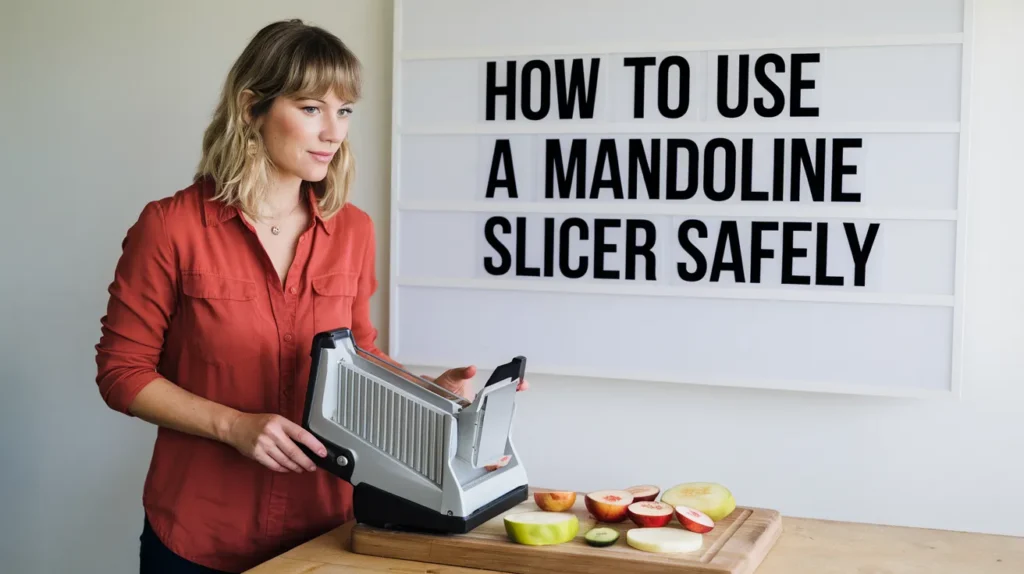To use a mandoline slicer safely, always use the hand guard or a cut-resistant glove to protect your fingers, and ensure the blade is sharp to prevent slipping. Keep your fingers curled inward and away from the blade, and work on a stable surface to maintain control.
When I first learned how to use a mandoline slicer safely, I didn’t realize just how sharp the blades were. This tool is amazing for slicing food quickly and efficiently, but it can be quite dangerous if not handled properly.
Did you know that in 2011, mandoline slicers and similar kitchen tools were responsible for approximately 21,699 emergency room visits? That’s a staggering number of accidents!
Here’s why understanding how to use a mandoline slicer safely is so important:
- The blades on mandolines are razor-sharp and can easily cause serious cuts.
- Beginners should always rely on safety guards, and even experienced users recommend them.
- Using protective gear, such as cut-resistant gloves, is a smart way to prevent injuries.
If you’re curious about how to use a mandoline slicer safely, don’t worry! By following proper techniques and using the right safety tools, you can confidently slice like a pro without risking harm.
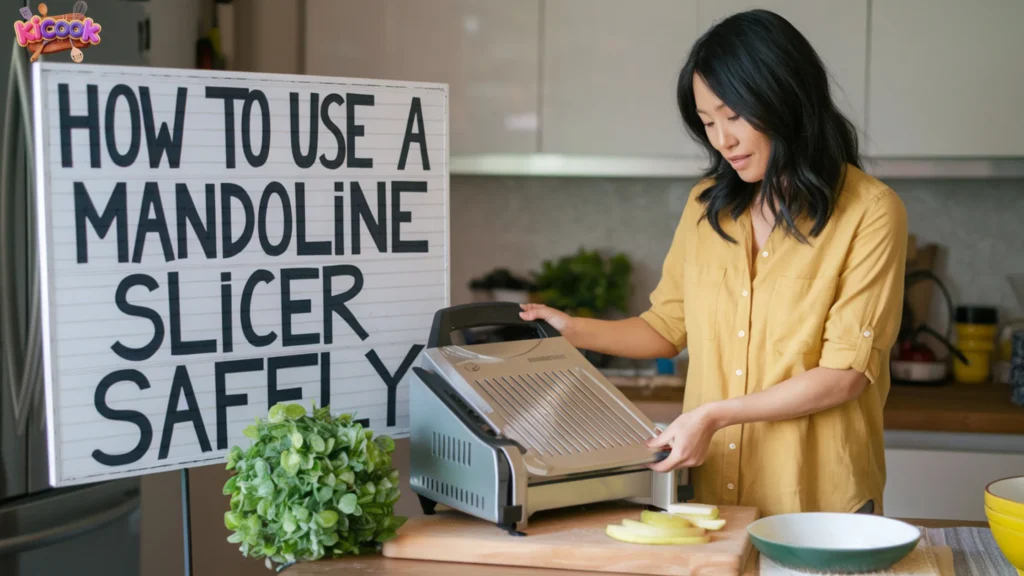
Main Points
- Always wear cut-proof gloves or use a handguard. These keep your hands safe from sharp blades.
- Place your mandoline slicer on a steady surface. A firm base stops slipping and helps slice evenly.
- Slice slowly and carefully for better results. Going too fast can cause uneven cuts or accidents.
- Clean your mandoline slicer often and check the blade. A clean slicer with a sharp blade works better and is safer.
- Pay attention while slicing and avoid distractions. Staying focused helps you cut safely and accurately.
What is a Mandoline slicer and its purpose?
Overview of a Mandoline slicer
The first time I saw a mandoline slicer, I thought it was just a fancy grater. But it’s much more than that! A mandoline slicer is a kitchen tool that helps cut fruits and vegetables into thin, even slices. It has a flat surface with a sharp blade in the center. You slide food across the blade, and you get perfect slices every time.
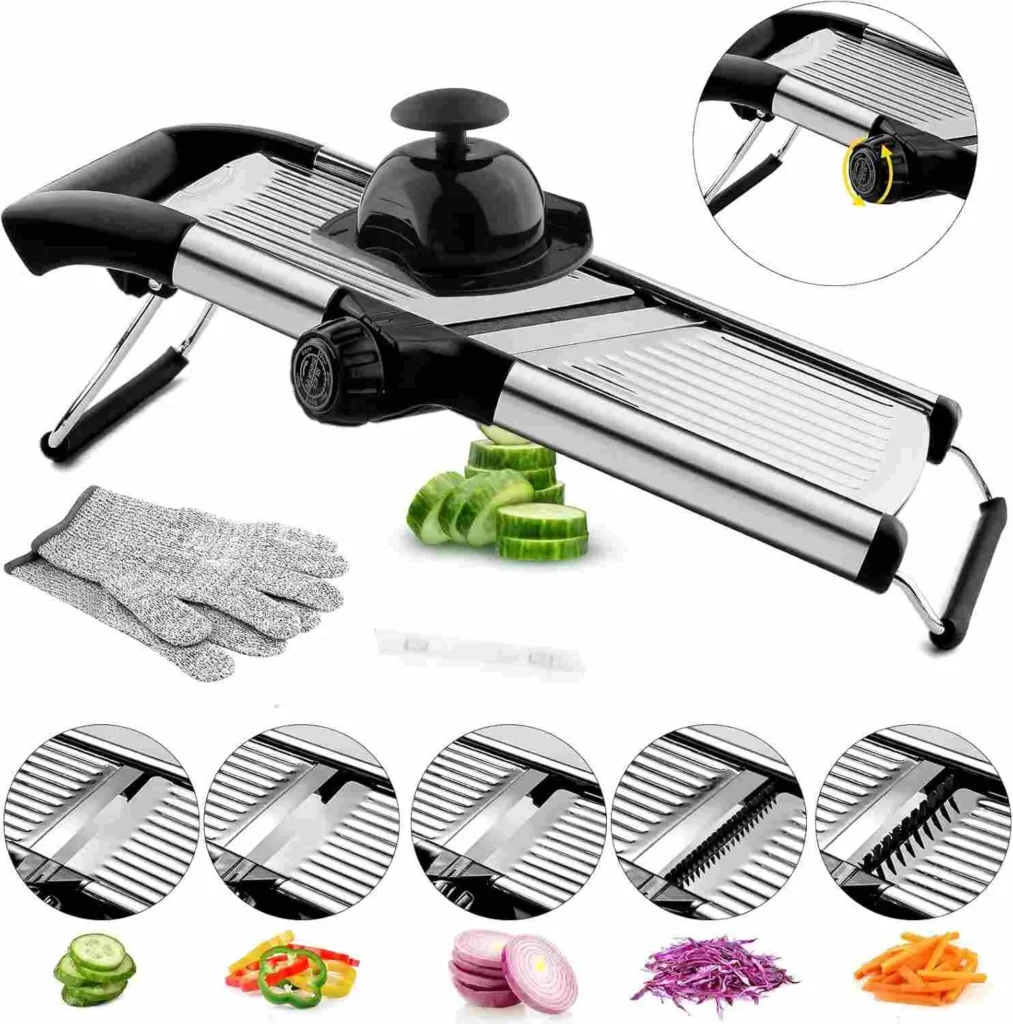
What makes it unique? It has different blades and settings. Most mandolines let you do flat slices, julienne cuts, or crinkle cuts. Some even allow you to change how thick or thin the slices are. Here’s a simple table of its features:
| Feature Type | Description |
|---|---|
| Blade Types | Includes flat slicing, julienne slicing, coarse shredding, fine shredding, and optional wavy blade for crinkle cuts. |
| Safety Practices | Use a finger guard, keep hands away from the blade, and store it safely to avoid injuries. |
| Suitable Produce | Not all foods work; soft or odd-shaped items like pineapple, grapes, and broccoli don’t slice well. |
I’ve learned that not all fruits or vegetables work with a mandoline. For example, soft foods like grapes or broccoli don’t slice properly. But for firm foods like potatoes, cucumbers, and carrots, it’s amazing.
“A mandoline doesn’t forgive mistakes—always respect the blade.” – Chef Julia Monroe
Benefits of using a Mandoline slicer
Why use a mandoline slicer? It’s fast and precise. It saves time compared to cutting by hand. Plus, the slices are always even, which helps food cook evenly. No more burnt edges or raw centers!
Another great thing? It’s versatile. I use mine to make potato chips, salad toppings, and zucchini noodles. It’s like having chef-level cutting skills without needing years of practice. And honestly, it’s really fun to use!
If you want to improve your cooking, a mandoline slicer is a great tool. Just be sure to use it safely, and you’ll love how easy it makes slicing.
How to use a Mandoline slicer safely?
Getting the Mandoline slicer ready
Before slicing, I check if my mandoline slicer is set up right. I place it so the slanted side points away from me. This helps me control it better and keeps my hands safe. If the food isn’t flat, I cut a steady base with a knife. This small step makes slicing easier and safer.
After setting it up, I use the guard or holder to secure the food. Skipping this step can cause accidents. I place the food in the holder above the blade and press evenly while slicing. This keeps the cuts smooth and prevents slipping.
Changing blade and thickness settings
One cool thing about a mandoline slicer is its adjustable settings. Before slicing, I check the blade and thickness options. Most slicers let you pick sizes like 0.5mm, 1.3mm, 2.0mm, or 3.0mm. Thin slices are great for chips, while thicker ones work for gratins.
The blade type is important too. I like ceramic blades because they’re sharp and safer. Dull blades can make food stick, forcing me to press harder and risk slipping. Keeping the blade sharp helps avoid accidents.
| Feature | Description |
|---|---|
| Blade Material | Sharp ceramic for clean cuts |
| Adjustable Thickness Settings | Four options: 0.5mm, 1.3mm, 2.0mm, 3.0mm |
| Usage | Easy and safe with corner notches |
| Handguard | Protects fingers and holds food securely |
Using the handguard and slicing food
When slicing, I always use the handguard. It might feel awkward at first, but it keeps my fingers safe. I secure the food in the holder and make sure it’s steady. Then, I slide it back and forth with even pressure. This keeps the slices neat and avoids accidents.
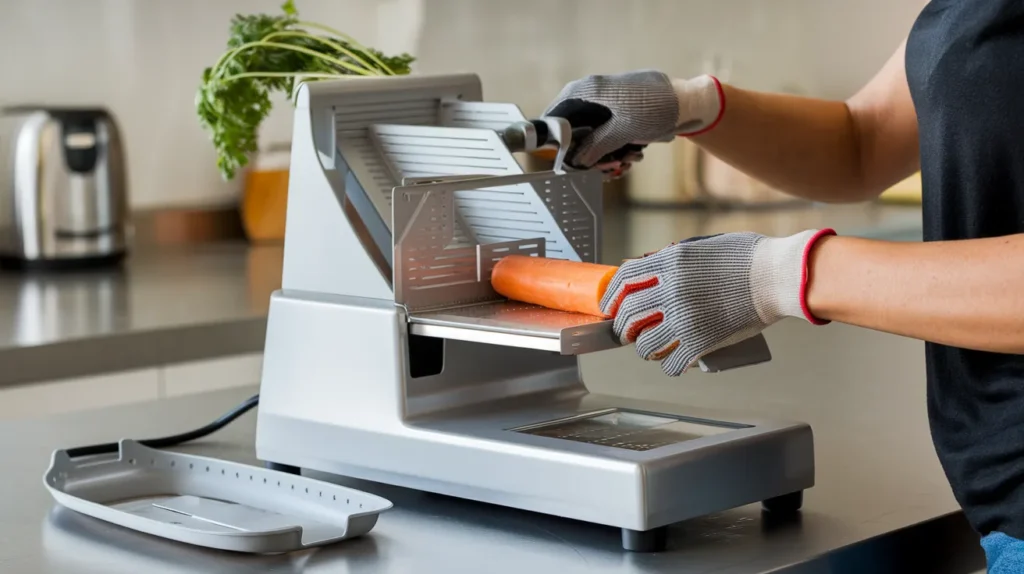
Sometimes, I wear cut-resistant gloves for extra safety. These gloves, often made of strong materials like Kevlar, make me feel more confident. Using both the handguard and gloves is a smart way to stay safe while learning to use a mandoline slicer.
Pro Tip: Stay focused while slicing. Even with safety tools, distractions can cause slips.
Essential safety tools for Mandoline slicer use
When I began using a mandoline slicer, I quickly learned safety tools are a must. These tools not only protect your hands but also make slicing easier and less stressful. Let me explain the key tools you’ll need.
Why handguards are important
The handguard is your main safety tool. It’s small but very helpful. It holds the food firmly and keeps your fingers away from the blade. I noticed that using a handguard gives me better control, especially with small or oddly shaped foods like radishes or zucchini.
Safety holders also stop food from slipping. This is important because slipping can cause uneven slices—or worse, injuries. If you’re new to mandoline slicers, always use the handguard. It might feel strange at first, but it’s worth it.
Quick Tip: Use cut-resistant gloves with the handguard for extra safety when slicing small foods.
Why cut-resistant gloves are helpful
Cut-resistant gloves are amazing. They’re made from strong materials like Kevlar or steel mesh. These gloves protect your hands from cuts while slicing foods too small for the handguard.
Here’s why I love them:
- They shield your hands from cuts and scrapes.
- The textured surface helps you grip slippery foods like cucumbers.
- They’re useful for other tasks, like grating cheese or peeling veggies.
Check out this table to see why cut-resistant gloves are essential:
| Benefit | Description |
|---|---|
| Enhanced Safety | Shields hands from cuts and injuries when using sharp tools. |
| Improved Grip and Dexterity | Textured gloves help hold slippery foods and allow precise cutting. |
| Versatility | Great for many kitchen tasks, improving safety and ease. |
| Food Safety Compliance | Made with food-safe materials to avoid contamination during cooking. |
Other safety tools to consider
Besides handguards and gloves, there are other tools to make slicing safer. For example, I prefer bamboo or stainless steel cutting boards over plastic ones. They’re sturdier and don’t slide as much.
Here are more tips I follow:
- Don’t heat food in plastic containers; they can release harmful chemicals.
- For families with kids, silicone or stainless steel tools are safer than plastic ones.
By using the right tools and following these tips, you can safely master the mandoline slicer. Staying safe not only protects you but also makes cooking more fun.
Tips for mindful slicing techniques
Maintaining focus and avoiding distractions
When I use a mandoline slicer, I make sure to stay focused. It’s easy to get distracted, especially when multitasking in the kitchen. But I’ve learned that even a momentary lapse can lead to accidents. I keep my workspace clear and organized. This helps me concentrate on slicing without worrying about clutter.
I also avoid using the slicer when I’m tired or in a rush. It’s tempting to speed through tasks, but rushing increases the risk of mistakes. Instead, I take my time and stay present. If I feel distracted, I pause and reset my focus.
Pro Tip: Turn off your phone or step away from conversations while slicing. Staying focused keeps your fingers safe!
Proper hand placement and grip
Hand placement is key when using a mandoline slicer. I always hold the handguard firmly and make sure my fingers stay far from the blade. It took me a few tries to get comfortable with the grip, but now it feels natural.
For foods that don’t fit well in the handguard, I wear cut-resistant gloves. These gloves give me extra confidence and help me maintain a steady grip. I also make sure the slicer is on a stable surface. A wobbly slicer can throw off my balance and lead to uneven cuts—or worse, injuries.
Quick Tip: If your slicer has rubber feet, check that they’re secure before you start slicing. Stability makes all the difference!
Slicing slowly and evenly
I’ve found that slicing slowly and evenly produces the best results. When I rush, the slices come out uneven, and I end up wasting food. By taking my time, I get perfect slices every time. Plus, it’s safer. Pressing too hard or moving too fast can cause slips.
Here’s a quick comparison of the benefits of slicing slowly and evenly:
| Feature | Benefit |
|---|---|
| Precision | Achieve perfect results every time. |
| Efficiency | Saves time and effort with consistent slicing. |
| Adjustable Thickness | Allows for tailored slicing from 0.1-8mm. |
I use the adjustable thickness settings to match the recipe I’m working on. For chips, I go for thin slices. For gratins, I choose thicker ones. The consistent slices cook evenly, which makes the dish look and taste better.
Callout: Wondering how to use a mandoline slicer safely? Start by slicing slowly and evenly. It’s the easiest way to stay safe and get great results!
Cleaning and storing your Mandoline slicer safely
Safe cleaning techniques to avoid cuts
Cleaning a mandoline slicer can feel tricky, but I’ve learned a few tips to make it safe and simple. First, I always remove the blade before washing. This keeps my hands far from the sharp edges. I hand-wash the blade carefully, keeping the sharp side pointed away from me. It’s a small step, but it makes a big difference in avoiding cuts.
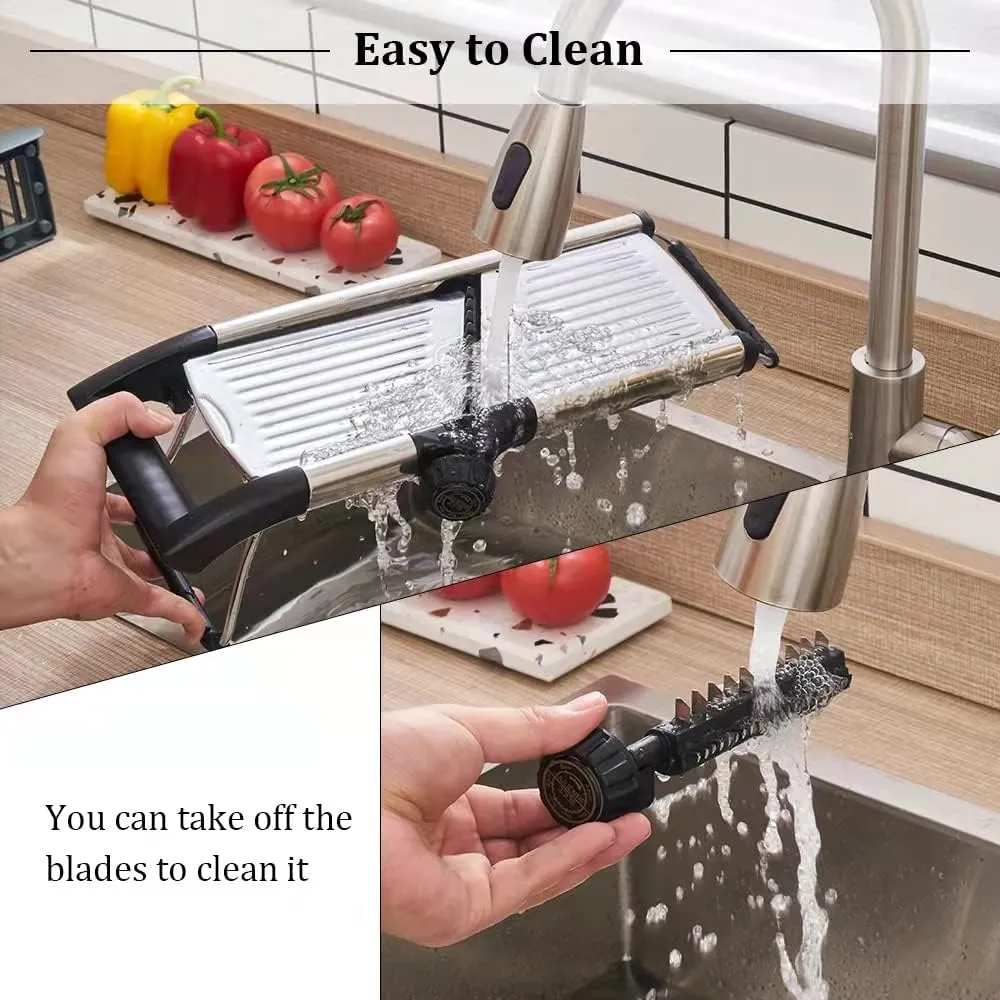
For the rest of the slicer, I either wash it by hand with warm, soapy water or pop it in the dishwasher if it’s dishwasher-safe. The handguard and food holder are easy to clean this way too. I never skip cleaning after each use. It keeps the blade sharp and prevents food from sticking.
Quick Tip: Use a soft brush or sponge to clean the blade. Avoid scrubbing with your hands to stay safe.
Proper drying and storage practices
Drying and storing your mandoline slicer properly is just as important as cleaning it. After washing, I dry each part thoroughly with a clean towel. This prevents rust from forming on the blade. For storage, I reassemble the slicer and place it in a safe spot, out of reach of kids and pets.
I also make sure the blade is covered or stored in its protective case. If your slicer doesn’t have one, wrapping the blade in a kitchen towel works well. Keeping it secure prevents accidental cuts when reaching for it.
Regular maintenance for long-term safety
Maintaining your mandoline slicer doesn’t take much time, but it keeps it working like new. I check the blade regularly to ensure it’s sharp. A dull blade can be more dangerous because it requires extra force to slice. If the blade starts to dull, I replace it or sharpen it using a proper tool.
I also inspect the handguard and rubber feet for wear. A stable slicer is safer to use. By taking these small steps, I keep my mandoline slicer in top shape and ready for safe slicing every time.
Callout: A well-maintained mandoline slicer isn’t just safer—it’s also more fun to use!
Using a mandoline slicer safely starts with understanding the tool and its features. I always make sure to follow these steps:
- Read the manual and get familiar with the slicer.
- Use a stable, non-slip cutting surface.
- Protect your hands with a handguard or gloves.
- Keep fingers far from the blade while slicing.
- Take your time and avoid rushing.
By practicing mindful slicing and cleaning habits, I’ve found that cooking becomes safer and more enjoyable. With these tips, you can confidently use a mandoline slicer and elevate your kitchen skills!
“Safety isn’t just a step—it’s the foundation of good cooking.” – Food Safety Expert Mark Linton
Frequently Asked Questions For use a Mandoline Slicer safely
What foods work best with a Mandoline slicer?
I’ve found that firm fruits and vegetables like potatoes, carrots, cucumbers, and apples work best. Soft or irregularly shaped foods, like tomatoes or broccoli, can be tricky. For softer items, chilling them slightly can help with slicing.
Can I use a Mandoline slicer without a handguard?
I wouldn’t recommend it. The handguard keeps your fingers safe from the sharp blade. If the food doesn’t fit in the handguard, I always wear cut-resistant gloves for extra protection.
How do I keep the blade sharp?
I clean the blade immediately after use and dry it thoroughly to prevent rust. If it starts to dull, I either sharpen it with a proper tool or replace it. A sharp blade makes slicing safer and easier.
Is a Mandoline slicer dishwasher-safe?
It depends on the model. Some are dishwasher-safe, but I prefer hand-washing mine to protect the blade. I use warm, soapy water and a soft brush to clean it safely.
What should I do if the slicer feels unstable?
If the slicer wobbles, I check the rubber feet for wear or dirt. Placing it on a damp towel can also help stabilize it. A steady slicer makes slicing safer and more efficient.
Pro Tip: Always double-check your slicer’s stability before starting. It’s a small step that makes a big difference!
Final Thoughts
Learning how to use a mandoline slicer safely ensures you enjoy its benefits without the risks. Always prioritize safety by using the hand guard, maintaining the blade, and handling the tool with care. With these tips, you’ll slice like a pro—safely and efficiently.
“Good tools make cooking easier, but good habits make it safer.” – Home Chef Rachel Dawson
By following these guidelines, you’ll master your mandoline slicer while keeping your fingers intact. Happy slicing!

